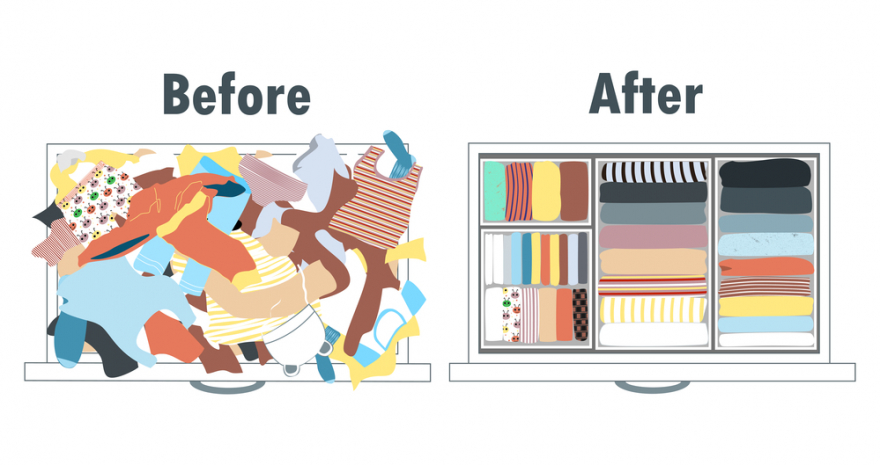I am happy to report that I am very close to being complete with my decluttering plan. I am also finding that part of the deal is that I have to commit to keeping things "tidy," so I don't get caught in the clutter trap in the future.
None of this kind of clearing and decluttering happens by accident. You have to create a plan. And then you have to commit to sticking to it if you are serious about it.
I am.
Some suggestions are offered below on how you might create your own plan if this is of interest to you. You don't have to undertake all the recommendations to be successful. But they may go a long way toward helping you get started if decluttering is something you would like to do for yourself and your family.
Start by first creating a plan you will commit to and stick with. Set goals. Then schedule the process. Get clear about what you want to tackle first. Do you want to use the KonMari method, or do you want to tackle room by room? If you take the time upfront to create a decluttering plan, you will be more likely to succeed.
1) Decide on Your Goals – Create a decluttering plan that inspires you. Set small goals for yourself. Then set up a timeline. Set goals for each room. You may not be able to do everything you want right away. So, some goals may be short term, and some may be long term.

2) Set Your Own Rules – Set ground rules for yourself. For example, don't succumb to the temptation of stopping when it gets hard in one room and moving to another. Stick with it. Finish the room or the category--whichever method you chose for yourself. Be careful not to over-schedule yourself. Set small goals so you can feel successful.
Success breeds more success.
3) Create a Reasonable Time Frame – Take out your calendar. Pick a date to start. Set reasonable goals for when you might finish a category or a room. Be flexible in case it doesn't go as smoothly as you would like. Try to make it fun!
4) One Room / Space / Category at a Time – When you create your schedule, don’t pick more than you can do realistically. Choose one category, one room, or one space to work on at a time. Maybe all you have time to do on your day off is to clean the kitchen drawers, for example. That’s okay. Being realistic about your plan is vital to your success.
5) Set Up a Space for Holding the Junk (For Now) – This process will take a while if you do it right.Choose a place to put boxes that are labeled, "Trash," "Keep," "Donate." Some people like a fourth box for items they want to sell. Organize the way you want that works for you. You need a place to keep these boxes while you’re going through the decluttering process. (I used the upstairs bathroom that no one uses.)

6) First Let Go of the Stuff Mentally - This has been discussed before, but it’s essential. When you tackle a room, you have to mentally let go of the idea that you need to keep everything--even things you no longer use. Allow yourself to forget about the money you’ve spent on the item. Instead, think of the money you’re going to save as you don’t buy more things you don’t need to clutter up your home ever again!
7) Use the Right Organizational Tools – Marie Kondo doesn't recommend that you buy commercial/plastic storage boxes. She doesn't even suggest that you buy a lot of fancy organizers. Small boxes can do the trick. She uses recycled shoe boxes and empty gift boxes of different sizes for different types of storage. I used a recycled box that came from Amazon the other day to hold some of the loose items in my utility drawer in the kitchen. It is incredible what a difference it makes! And it was the perfect size!!!
8) Develop Clutter-Free Habits – Even before decluttering one room, start developing clutter-free habits. For example, touch the mail once while you stand over the garbage. Inventory and organize everything you have. Toss things the moment you don’t need them and stop buying things without a plan for its use.

The one thing you’re going to learn with decluttering is how small actions can make a huge difference. You’ll realize that you have far more control over your environment than you ever thought possible. It may be decluttering your physical environment, but it’s also freeing you up mentally for success in every aspect of your life.
It is hard to explain just how exhilarating this process can be. It was at times exhausting, I admit. But I was determined to stick with it.
And the benefits are unexpected. By taking control of my closet space which had intimidated me for the last two years, I took control of myself. I exerted the self-discipline to tackle what felt like a daunting task and stuck with it until it was complete. I felt more confident about myself and more competent in my ability to stick with something difficult. And it did, in fact, spark "joy."
This may not be something you care about right now. But we all face times in our lives when we are faced with getting rid of stuff. Someone dies. How do you manage the disposal of their belongings? We almost all move every so often. You either need to downsize or evaluate what to take with you and what you wish to replace.
The decisions that go with this process can be useful in other areas of your life, too. The point is to get yourself unstuck. Don't fall victim to your stuff. Don't let your clutter control you. Take control of your clutter and clear out what you no longer need.
Clearing the space in your home or office can provide more room for being creative and productive. Don't believe me? Try it.
Until next time.